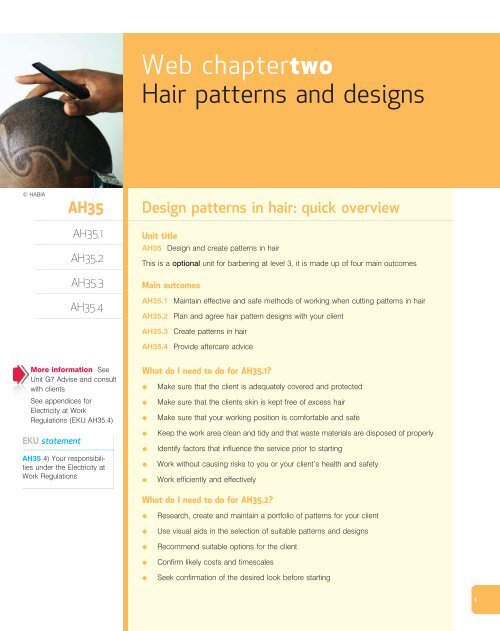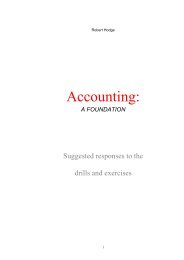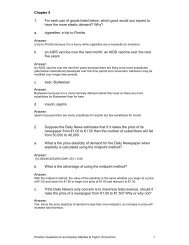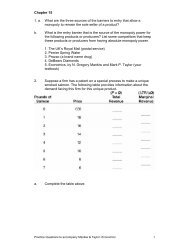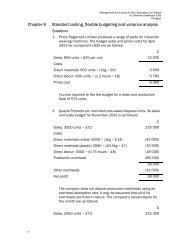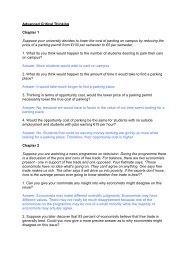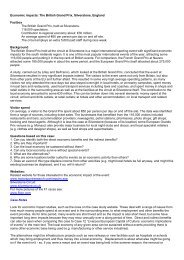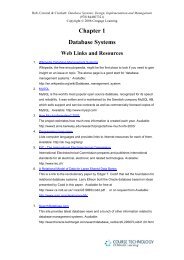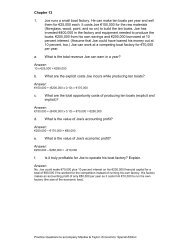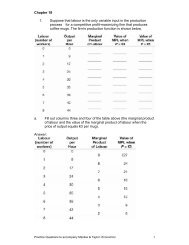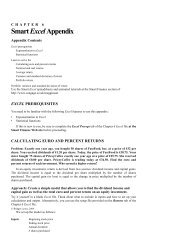Web chaptertwo Hair patterns and designs - Cengage Learning
Web chaptertwo Hair patterns and designs - Cengage Learning
Web chaptertwo Hair patterns and designs - Cengage Learning
You also want an ePaper? Increase the reach of your titles
YUMPU automatically turns print PDFs into web optimized ePapers that Google loves.
<strong>Web</strong> <strong>chaptertwo</strong><strong>Hair</strong> <strong>patterns</strong> <strong>and</strong> <strong>designs</strong>© HABIAAH35.....................................................................................................................................................................................AH35.1.....................................................................................................................................................................................AH35.2.....................................................................................................................................................................................AH35.3.....................................................................................................................................................................................AH35.4.....................................................................................................................................................................................Design <strong>patterns</strong> in hair: quick overview.......................................................................................................................................................................................................................................................................................................................................................................................................................................................................................................................................................................................................................................................................................................Unit titleAH35 Design <strong>and</strong> create <strong>patterns</strong> in hairThis is a optional unit for barbering at level 3, it is made up of four main outcomesMain outcomesAH35.1 Maintain effective <strong>and</strong> safe methods of working when cutting <strong>patterns</strong> in hairAH35.2 Plan <strong>and</strong> agree hair pattern <strong>designs</strong> with your clientAH35.3 Create <strong>patterns</strong> in hairAH35.4 Provide aftercare adviceMore information SeeUnit G7 Advise <strong>and</strong> consultwith clientsSee appendices forElectricity at WorkRegulations (EKU AH35.4)EKU statementAH35 4) Your responsibilitiesunder the Electricity atWork Regulations.What do I need to do for AH35.1?lllllllMake sure that the client is adequately covered <strong>and</strong> protectedMake sure that the clients skin is kept free of excess hairMake sure that your working position is comfortable <strong>and</strong> safeKeep the work area clean <strong>and</strong> tidy <strong>and</strong> that waste materials are disposed of properlyIdentify factors that influence the service prior to startingWork without causing risks to you or your client’s health <strong>and</strong> safetyWork efficiently <strong>and</strong> effectively............................................................................................................................................................................................................................................................................................................What do I need to do for AH35.2?lllllResearch, create <strong>and</strong> maintain a portfolio of <strong>patterns</strong> for your clientUse visual aids in the selection of suitable <strong>patterns</strong> <strong>and</strong> <strong>designs</strong>Recommend suitable options for the clientConfirm likely costs <strong>and</strong> timescalesSeek confirmation of the desired look before starting1
2NVQ3 <strong>Hair</strong> <strong>patterns</strong> <strong>and</strong> <strong>designs</strong> AH35KeywordsFreeh<strong>and</strong> cuttingA method of cutting withoutholding hair between the fingersor below or above a combScissor over combA technique of cutting hairwith scissors, using the backof the comb as a guide,especially when the hair is ata length that cannot be heldbetween the fingersClipper over combA technique of cutting hair withelectric clippers, using the back ofthe comb as a guide, especially onvery short hair <strong>and</strong> hairline profilesFadingA cutting term that refers to thesmooth blending of two differenthair lengths within a haircut oralternatively as a taperingtechnique where very short hair isfaded out to the perimeter skin; forexample at the nape area whereclippered hair lengths are blendeddown to a length of grade 1.What do I need to do for AH35.3?llllllPosition the pattern stencil accuratelyAdapt <strong>and</strong> scale the design accordinglyCombine cutting techniques to achieve the desired outcomeCheck <strong>and</strong> consult with the client throughout the processTake actions to resolve problems that ariseConfirm the finished outcome with the clientWhat do I need to do for AH35.4?lGive the client accurate, constructive advice on how they canmaintain the look themselvesWhat aspects do I need to cover for AH35.1, AH35.2, AH35.3<strong>and</strong> AH35.4?llllA variety of cutting tools <strong>and</strong> equipmentA range of factors that influence or limit the choice of styling3D pictorial <strong>patterns</strong>, symmetrical effects <strong>and</strong> repeated <strong>designs</strong>Different types of cutting techniques that are used to create theeffectsWhat aspects do I need to know for AH35.1, AH35.2, AH35.3<strong>and</strong> AH35.4?lllYour salon’s requirements for preparation, timings <strong>and</strong> st<strong>and</strong>ardsof serviceHow to work safely, effectively <strong>and</strong> hygienically when cutting facialhairBasic design principles of scale <strong>and</strong> proportionInversed clipperingA way of holding the clippers toproduce outlines necklines <strong>and</strong>detail within a designTramlinerA specialist clipper with atapered, narrow blade fordetailing <strong>designs</strong> on hair‘T’ linerA type of clipper with a differentblade type to st<strong>and</strong>ard clippers,enabling closer cut outlinesaround ears, necklines <strong>and</strong>facial hair shapesllllFactors about the client that affect design choice, suitability <strong>and</strong>durabilityThe ways of methodically cutting hair to achieve the desired effectsin 2D <strong>and</strong> 3DHow to correct commonly occurring problems that can occurduring the cuttingThe aftercare advice <strong>and</strong> recommendations that you should give toclients
Introduction<strong>Hair</strong> design <strong>and</strong> scalp tattooing both have their origins in tribal <strong>and</strong> ethnic cultures. Theranges of effects achievable are only limited by the imagination <strong>and</strong> the subject matterfor this work is international.<strong>Hair</strong> design in the UK has only scratched the surface; it has been used historically, todifferentiate between different ethnic groups. More recently it became a radical, anarchicstatement of youth culture in the punk rock era <strong>and</strong> latterly in the USA it can differentiatebetween mobs <strong>and</strong> gangs. Again the main driver for its popularity is music <strong>and</strong> if in that itpersists, then there will be huge requirement for this type of work in the future.To prove its validity <strong>and</strong> support for this on a global scale, it has an international seal ofapproval, as it is used within one of the eight test projects for the biannual WorldSkillscompetitions.llllInformation coveredin this chapterThe tools <strong>and</strong> equipmentused during cuttingThe preparations that youshould make prior to cutting<strong>patterns</strong> <strong>and</strong> <strong>designs</strong> in hairThe factors that influencehair cutting decisionsThe basic principles ofdesign e.g. scaling,proportion, two <strong>and</strong> threedimensions3NVQ3 <strong>Hair</strong> <strong>patterns</strong> <strong>and</strong> <strong>designs</strong> AH35llCutting <strong>and</strong> styling hairtechniquesThe aftercare advice thatyou should give clientsAH35.1Maintain effective <strong>and</strong> safe methods of workingwhen cutting <strong>patterns</strong> in hairMuch of the preparations of materials, tools <strong>and</strong> clients needed for this service aresimilar to that elsewhere in the book. If you are not familiar with this aspect of the servicethen see Chapter 15 in the book Unit G22 Monitor procedures to safely control workoperations.For specific information on the following topics, review the pages specified.Tools <strong>and</strong> client preparationSee Chapter 6, Unit GB7 Design <strong>and</strong> create a range of facial shapes pp. 131–139.Hygiene <strong>and</strong> sterilisationSee Chapter 6, Unit GB7 Design <strong>and</strong> create a range of facial shapes p.132 <strong>and</strong>pp. 138–139.EKU AH35 3) Your salon’s <strong>and</strong> legal requirements for disposal of sharps <strong>and</strong> waste materialsEKU AH35 7) Why it is important to protect clients from hair cuttingsEKU AH35 10) Why it is important to check for infestation <strong>and</strong> avoid cross-infectionEKU AH35 12) Methods of sterilisation used in barber shopsEKU AH35 13) Methods of working safely <strong>and</strong> hygienically <strong>and</strong> which minimise the risk ofcross-infection <strong>and</strong> cross-infestationEKU AH35 16) The importance of personal hygieneEKU statementAH35 1) Your salon’srequirements for clientpreparationAH35 6) The range ofprotective equipment thatshould be available forclientsAH35 11) Why it isimportant to keep your workarea clean <strong>and</strong> tidy............................................................................................................................................................................................................................................................................................................EKU statementAH35 9) The safetyconsiderations which mustbe taken into account whencutting <strong>patterns</strong> in hair..............................................................................................................................................................................................................................................................................................................
4NVQ3 <strong>Hair</strong> <strong>patterns</strong> <strong>and</strong> <strong>designs</strong> AH35RememberDisposal of sharp itemsUsed razor blades <strong>and</strong>similar items should beplaced into a safe container(‘sharps box’). See Chapter 5Disposal of wastes <strong>and</strong> sharps.EKU statementAH35 8) How the positionof your client <strong>and</strong> yourselfcan affect the desiredoutcome <strong>and</strong> reducefatigue <strong>and</strong> the risk of injuryAH35 15) Why it isimportant to position yourcutting tools for ease of use.............................................................................................................................................................................................................................................................................................................Cutting techniquesSee Unit GH16 Creatively cut hair using a combination of cutting techniques.Working position, comfort <strong>and</strong> safetySee Unit GB7 Design <strong>and</strong> create a range of facial shapes pp. 131–132.Working effectively <strong>and</strong> efficientlySee Unit GB7 Design <strong>and</strong> create a range of facial shapes p. 132.EKU AH35 2) Your salon’s expected service times for cutting <strong>patterns</strong> in hairWhat is your salon policy for the use of razors<strong>and</strong> the disposal of sharp items?See Unit GB8 Creatively cut hair using a combination of barbering techniques p. 108 <strong>and</strong>Unit GB7 Design <strong>and</strong> create a range of facial shapes p. 133.EKU AH35 5) Any limitations placed on your use of razors by your local bye-laws <strong>and</strong>legislationEKU statementAH35 14) The correct use<strong>and</strong> maintenance of cuttingtools.Cutting toolsScissors............................................................................................................................................................................................................................................................................................................For more information on scissors, types <strong>and</strong> maintenance see Unit GH16 Creatively cuthair using a combination of techniques pp. 84–85 <strong>and</strong> Unit GB8 creatively barbering.ClippersSee Unit GB7, p. 1 <strong>and</strong> Unit GB8, p. 117.Clipper type Blade profile UsesSt<strong>and</strong>ard clipperWAHL (UK) LTDSt<strong>and</strong>ard width clippers are a general ‘catch-all’ piece of equipment.Available in mains or rechargeable power options, they willcomfortably manage the cutting of large amounts of hair very quickly.They can be fitted with a variety of grade attachments <strong>and</strong> areessential to men’s barbering.T liner/outlinerCOURTESY OF BABYLISS PRO‘T’ liners/outliners are a more specialised clipper that has a T shapedblade. The fixed blade extends beyond the width of the clipper bodyenabling them to be used around the ears or facial hair shapes;providing a closer, (yet safe) cut finish than that of st<strong>and</strong>ard clippers.TramlinerCOURTESY OF BABYLISS PROA tramliner is a specialist narrow blade clipper, designed for intricatelining <strong>and</strong> detailing of hair. These types of clipper enable you to cutfree-form <strong>designs</strong> without inverse etching techniques that you wouldneed to use with the other types of clipper.
6NVQ3 <strong>Hair</strong> <strong>patterns</strong> <strong>and</strong> <strong>designs</strong> AH35EKU statementAH35 23) How to hold adiscussion with a client <strong>and</strong>assist your client to reachan informed decision on apatternAH35 24) How to presentinformation <strong>and</strong>recommendations on<strong>patterns</strong> clearly to clients.............................................................................................................................................................................................................................................................................................................Try to show breadth <strong>and</strong> depth in your portfolio of work; try to cover aspects that addressall sorts of design modes, as this will indicate to others that you have the ability to adaptto/in any situation.Working with <strong>designs</strong>In looking for material to add to your portfolio, you are more likely to find aspects orelements of images that you want to use within larger <strong>designs</strong> or images. It is unlikelythat you will find complete, finished compositions of work to show clients <strong>and</strong> withoutthese finished effects; you can’t expect a warm, enthusiastic response from clients.Very few people have the artistic ability to be able to visualise a photograph of a finishedlook, let alone an element of a design or a pattern upon them. You need to find ways of:l making the design or pattern largerl incorporating the design into a finished effect.EKU statementAH35 25) Basic principlesof design, scale <strong>and</strong>proportionAH35 26) How to scale<strong>designs</strong> up <strong>and</strong> down tosuit different head shapesAH35 35) Techniques forachieving accuraterepeated <strong>and</strong> symmetrical<strong>patterns</strong>AH35 36) How to adaptyour cutting techniques tocreate two-dimensional(2D) <strong>and</strong> three-dimensional<strong>patterns</strong> (3D).............................................................................................................................................................................................................................................................................................................ActivityDeveloping a portfolio of ideasWhen you find a pattern or a design that you want to add to your portfolio,you need to keep the original image or source <strong>and</strong> create your artwork fromit as the design that you will use as a visual aid with clients. This will becomeboth the source for themes <strong>and</strong> ideas for the client as well a tool to promptdiscussion about the work.You should have two physical components to the work:1 The first is the original research or source item – this could be in theform of a photograph, magazine cuttings, internet downloads orsketches. These original compositions could be on paper, textiles <strong>and</strong>packaging or on digital media. How you keep them for your portfolio isup to you, but you will need to show your themes to assessors as partof a ‘story board’ of ideas. (A story board is a creative narrative that iscomposed of ideas leading to a finished, physical result.)2 The second is the composition of finished effects – for usefulness, it ismore likely that you will want to use this within a working environment<strong>and</strong> therefore the research material is superfluous in a portfolio that youwant to share with clients. The journey that you take in finding sources ofdesign material <strong>and</strong> turning them into finished works is a personal,learning activity. It is unlikely that the design roughs will be of muchinterest to the client, other than the fact that it is a topic for discussion; forexample, ‘So where did you get the idea for this design?’‘Well actually; itwas a photograph of an airbrushed design on the fuel tank of a HarleyDavidson motorbike, I saw on holiday.’ The collections of finished workswill probably be in an album, a visual aid that you can show <strong>and</strong> sharewith the client, compiled with individual pages <strong>and</strong> themes.This is only an idea <strong>and</strong> depends on the extent of presentation media you have in theshop. For example, a tattooist will cover their walls with themes <strong>and</strong> examples of theirwork. A swish, up-to-the-minute, computer-minded barbers’ may use projected slideshowsor compositions burned to DVD <strong>and</strong> run as a visual presentations as part of thein-shop entertainment. The way that you put your ideas together, work <strong>and</strong> develop them<strong>and</strong> finally present them is up to you.
ActivityScaling a design to create a stencilDesign ideas can come from all types of sources <strong>and</strong> you might find <strong>patterns</strong> <strong>and</strong> things that you could use in allsorts of improbable places. Ideas may come from textiles, fabrics, nature, or printed media <strong>and</strong> initially they can bequite detailed or small.So, the first part of working with a small idea is to make it a big idea!You need to take your original design drafts <strong>and</strong> scale them to a size on a medium that you can apply in a ‘life-size’context. The original may be a photograph but the working template may need to be transparent, such as A4transparent film. A material like this would be reusable, durable <strong>and</strong> detailed <strong>and</strong>, most important of all, it can beturned around to create a mirror image, ideal for creating symmetrical <strong>designs</strong> for either side of the head.There are a number of ways that you can take a small design <strong>and</strong> turn it into a larger working template, i.e. a stencil<strong>and</strong> a lot depends on the resources <strong>and</strong> skills that you have.7NVQ3 <strong>Hair</strong> <strong>patterns</strong> <strong>and</strong> <strong>designs</strong> AH35Computer-aided scalingIf you are familiar with using a computer <strong>and</strong> have access to a scanner. You can import a photograph or illustrationinto a document (such as Microsoft Word, Open Office, Lotus Word Pro) by simply choosing File – Import – Picture<strong>and</strong> selecting the image that you want. Once the image is on the document, you can then centre it <strong>and</strong> then select it.It will then show an editable border which can be scaled or exp<strong>and</strong>ed to any size that you want.When you have achieved the size that you want, you can modify the colours, the degree of transparency of the imageor even reduce it to a black-<strong>and</strong>-white illustration. After saving the document you can then print it out later on paper,glossy photo quality paper or transparent film.A word of advice: if you want to provide the client with more information than just an outline, print your design as aphotograph <strong>and</strong> a working transparent film template. This way the client gets more of the idea ofwhat you are doing, whilst you have the working design next to it. If you keep them in clear, folder sleeves, they canbe kept in a ring binder together.Manual scalingIf you prefer to work with the originals in a more ‘h<strong>and</strong>s on’ artistic way, you can use the traditional method ofscaling <strong>designs</strong>. This is done by taking the original image <strong>and</strong> placing it on your work surface. Take two pieces oftracing paper or transparent film <strong>and</strong> mark out the sides in the following way. Take a ruler with say both centimeters<strong>and</strong> inches on it. Then, on the first piece, accurately mark out the sides at centimeter intervals, after marking thefilm, join up the marks with a fine-tipped felt tip pen to create a table or grid pattern. Do the same to the other pieceof film but at inch intervals instead of centimeters (see the first two figures below).1. Table marked out withcentimetre intervals2. Table marked out withinch intervals
8NVQ3 <strong>Hair</strong> <strong>patterns</strong> <strong>and</strong> <strong>designs</strong> AH35Then place your original source image underneath the grid with the smaller squares. (You can use masking tape ifyou want to make sure it stays securely in position.) Then, working from above <strong>and</strong> looking at the design below, traceoff with a pencil (if you are using tracing paper) or with a washable, fine-tipped felt pen (if you are using plastic film)the outlines on to the grid (see the next two figures below).Original artwork underneath transparent filmThen with your finished artwork marked out (<strong>and</strong> coloured in if necessary) you can use the positions on the squareswhere your design intersects, to provide a template for drawing <strong>and</strong> transposing the original image on to the largergrid. This scales up the drawing <strong>and</strong> provides you with a larger artwork. It is also worth remembering that you canscale down your <strong>designs</strong> by starting with the larger grid <strong>and</strong> working the detail into a smaller grid (see the next twofigures).Re-drawn artwork scaled up on larger gridYou now have a finished artwork that you can add to your design portfolio. The complexity, colours <strong>and</strong> sources forideas are up to you.RememberKeep all the sourcematerial in your originatingportfoliosothatyoucanprovide your assessor with a‘storyboard’ of the elements thatcreate your final <strong>designs</strong>.Style aspectsHead <strong>and</strong> facial shapeThe proportions, balance <strong>and</strong> distribution of weight in the design will be a frame for thehead <strong>and</strong> face. Therefore you need to examine the head <strong>and</strong> face carefully. If you lookat the outline of your client’s face, you will see that it’s either round, oval, square,
heart-shaped, oblong or triangular. Imagine what the head will look like with less hair; willit expose features that enhance the design plan, or will the factors work against yourpreliminary ideas?Would the design benefit from more hair? Is the client’s hair long enough to produce the3D effect? These are the sorts of questions that you need to answer before embarkingon some ‘flashy’ self-advertisement campaign.Does the client’s physical features present some form of styling limitations? These areissues that are critical to the achievement of a satisfactory result.<strong>Hair</strong> design considerationsThe perimeters <strong>and</strong> design outlines formed by the hair in relation to the shape of the faceis the first thing people will see. It is this effect that people make decisions upon <strong>and</strong>comments about; for example, ‘That’s a great effect’; ‘I think that really suits you.’ Thecomplete hair design is based upon suitability matched to personality or image aspects.How you ‘fill in’ the detail – the movement, direction, colour <strong>and</strong> patterning – is down toyour interpretation <strong>and</strong> underst<strong>and</strong>ing of the client <strong>and</strong> what is suitable for them. Don’texpect them to be the best at self-visualisation. If they produce ideas that seem off-beator r<strong>and</strong>om; ask them if there is any particular reason why they would want to takethat line.EKU statementAH35 27) The designpossibilities <strong>and</strong> limitationswhen working on hairAH35 45) How their hairtexture affects their patterndesign possibilities.............................................................................................................................................................................................................................................................................................................9NVQ3 <strong>Hair</strong> <strong>patterns</strong> <strong>and</strong> <strong>designs</strong> AH35<strong>Hair</strong> positioning, type, growth <strong>and</strong> tendency<strong>Hair</strong> growth direction <strong>and</strong> distribution should be a major consideration for what is achievablewithin a hairstyle. You need to make allowances for strong movement, high or low hairlines,natural partings, hair whorls, cowlicks, widow’s peaks <strong>and</strong> double crowns. Look for thesebefore shampooing. The client cannot compensate for these themselves, so when the hairis in need of washing, they will be plain to see. After the hair is washed the degree <strong>and</strong>strength of the feature can be seen <strong>and</strong> then you can reconsider how you will tackle it.<strong>Hair</strong> pattern suitabilityPattern suitability refers to the effect of the hair design in relation to the face <strong>and</strong> on thefeatures of the head <strong>and</strong> body. From an aesthetic point of view, a hair design is suitablewhen it ‘looks right’. But this is a difficult or certainly a subjective thing to quantify.Aesthetically <strong>and</strong> artistically speaking, the client’s ‘hair will look right’ when the <strong>designs</strong>do one of two things. It either:l Harmonises, i.e. fits <strong>and</strong> works with the shape of the face <strong>and</strong> head – <strong>and</strong>therefore provides an enhancement to an overall image orl Contrasts, i.e. it accentuates features of the face <strong>and</strong> head – by creating aprominent, strong or stark overall image.For example, when working with harmonising aspects; the features <strong>and</strong> lines of the face<strong>and</strong> its underlying bone structure is accentuated when the linear (straight) lines <strong>and</strong><strong>patterns</strong> within the hair design are continuous with it.The opposite <strong>and</strong> contrast to linear effects occur when, hair <strong>designs</strong> are not continuous<strong>and</strong> cross at right angles against the lines <strong>and</strong> features of the face.RememberAs a general rule linear,straight-lined effects <strong>and</strong>box-like shapes arevisually harder <strong>and</strong> can appearmore threatening or brutal thanthose <strong>designs</strong> incorporatingcurves, circles <strong>and</strong> ellipses.
10Similarly, a softening effect is created when curves move away from the hairlines producingharmonising effects.NVQ3 <strong>Hair</strong> <strong>patterns</strong> <strong>and</strong> <strong>designs</strong> AH35Basic principles of designBalanceBalance is the effect produced by the proportions <strong>and</strong> distribution of detail throughoutthe style. The opposite, i.e. imbalance, is lack of those proportions. Symmetry or symmetricaleven balance occurs when the effects are distributed equally as in a mirroredimage through a vertical or horizontal plane. Asymmetry or asymmetric effects occurwhen the overall shape does not have the same distribution on either side.EKU statementAH35 28) The factors thatmust be taken intoconsideration prior tocutting (including hairgrowth <strong>patterns</strong>, hairdensity, scarring etc.) <strong>and</strong>how they may limit or affectthe achievement of <strong>patterns</strong>AH35 39) The importanceof considering the density,texture <strong>and</strong> working with thenatural growth <strong>patterns</strong> ofthe hair............................................................................................................................................................................................................................................................................................................EKU statementAH35 17) The importanceof questioning clients toestablish any contraindicationsto the shavingserviceAH35 18) Why it isimportant to record clientresponses to questionsAH35 19) The legalsignificance of clientquestioning <strong>and</strong> orrecording the client’sresponsesAH35 20) The importanceof keeping <strong>and</strong> maintainingclient recordsAH35 44) How lifestyle caninfluence the client’s choiceof style (e.g. active sports,career <strong>and</strong> jobrequirements)..............................................................................................................................................................................................................................................................................................................However, both symmetrical <strong>and</strong> asymmetrical shapes can be balanced – see the illustration‘Aesthetic (offset) balance’. Here the aspect of perspective is brought into playwhere a visually larger component is counterbalanced by a smaller one further away.Style lineStyle lines are the directions in which the hair design is positioned or appears to flow.When a break occurs within this flow the eye is immediately drawn to it. A break can onlyhappen for two reasons: either it’s a style feature <strong>and</strong> accentuates what the observer ismeant to see, otherwise, it’s a mistake made by the inexperienced.Partings <strong>and</strong> divisionsPartings or divisions in hair have a strong impact. Lines created upon the head will drawthe attention of the eye <strong>and</strong> can be used to create flow <strong>and</strong> movement away from theface to the detail that lies beyond.MovementMovement refers to the variance of line direction within a hair design. The more variety indirection the more movement there will be. Sometimes this movement is because ofnatural tendency – to accommodate curls or waves – sometimes it is deliberately createdby design shaping <strong>and</strong> placement.Hard <strong>and</strong> soft effectsHard <strong>and</strong> soft effects result from the balance or imbalance within a hair design or fromthe movement or lack of movement within it. Subtle lining will convey softer harmonisingeffects, whereas stronger lines produce contrasting effects, which work better in achievingmore dramatic results.ConsultationWith most of the planning <strong>and</strong> preparations done, your main concern is establishingwith the client exactly what is going to happen <strong>and</strong> gaining from them the confirmationthat what you have selected as a design is both appropriate <strong>and</strong> satisfactory. If thereis any hesitation or uncertainty, you need to either provide more information about
what you intend to do, or re-look at the visuals from your portfolio to explore otheroptions.Look for contra-indications to hairdesign workThe request for a hair design or close cut patterning may be wanted by the client, but notevery client will be able to have the service. Always look closely for signs to see if theservice can be provided <strong>and</strong> ask the client if they have any reasons that they know of thatwould not permit the service to be conducted.Do not provide this service when:l there are signs of cuts, abrasions on the scalpl there are signs of reddening from conditions like eczema or skin sensitivity or skinallergiesl there are any other adverse symptoms such as infections or infestationsl there are uneven skin conditions.Pre-cuttingDiversion The other aspectsfor consideration in generalconsultation relating to adverseor influencing factors arecovered elsewhere in the book.Review Unit G21, Providehairdressing consultationservices for more information(see pp. 4–43).RememberIf you have any doubtsabout symptoms <strong>and</strong>contra-indications;always ask a senior member ofstaff for their assistance. Youmay be putting the salon at riskfrom legal action or pursuance ifyou don’t follow this processproperly.11NVQ3 <strong>Hair</strong> <strong>patterns</strong> <strong>and</strong> <strong>designs</strong> AH35In order to work with manageable lengths of hair, you need to pre-cut the client’s hair to alength that will enable you to transfer your <strong>designs</strong> to the head allowing for the longestparts of the 3D detail. Carefully, look at the length you are working with <strong>and</strong> make surethat you don’t undercut the hair length that you need to complete the total effect.Inaccurate detailingThe most common cutting problem is that of inaccurate detailing. It happens whenclippers take too much hair away from the area you want to work with. There are twoways in which you can compensate for this mistake.1 Make sure that you remove all lose clippings as you go along. Any cut hair left onthe scalp will lead you into believing that there is still more to work with; keepbrushing away the area that you are working with so that you clearly see where youare.2 If you do take too much hair away in a particular area, you need to stop <strong>and</strong> seehow much impact it will make on the overall design. You can then choose betweenmodifying your patterning to incorporate a different detailing or re-working thedesign plan to accommodate another theme or effect.Transferring a design to the headWith a collection of work done; your basic portfolio is complete. You now have <strong>designs</strong>covering a range of themes <strong>and</strong> along with this, you may have given a small descriptionor brief on how you found the sources for your artworks.EKU statementAH35 22) The importanceof consulting with clientsthroughout the cuttingprocessAH35 32) Methods ofpreparing the hair prior tocutting <strong>patterns</strong>AH35 33) The range of haircuts which form a suitablefoundation for cutting<strong>patterns</strong> into the hairAH35 34) Methods ofpreparing the hair prior tocutting <strong>patterns</strong>AH35 37) The importanceof visually checking the cutAH35 38) How to visuallycheck the design, pattern<strong>and</strong> cutAH35 40) The types ofproblems that cancommonly arise whencutting <strong>patterns</strong> in hair <strong>and</strong>ways in which they can beresolved, if possible.............................................................................................................................................................................................................................................................................................................
12NVQ3 <strong>Hair</strong> <strong>patterns</strong> <strong>and</strong> <strong>designs</strong> AH35PHOTO COURTESY OF UK SKILLSDonna Leach representing the UKin WorldSkills 2007 Team UKMedals, Shizuoka, JapanRememberA kohl pencil or whitepencil is sufficient to markeither dark or fair hair <strong>and</strong>any misdrawn areas can beremoved during shampooingafterwards.If the barber’s in which you work do a lot of hair design <strong>and</strong> pattern work, they wouldprobably have found a fast commercial way of transferring stencil design to the head, if itis a service that is ‘few <strong>and</strong> far between’ then a simpler process will suffice.The hardest part of transferring <strong>designs</strong> from stencils to the head is the re-drawingstage. Here your stencil (or paper-based) design has to be positioned <strong>and</strong> redrawn witha dark eyeliner-type pencil (for fairer hair types) or white pencil (for darker hair). Theaccuracy <strong>and</strong> time afforded to this part of the process is directly related to the quality ofthe finished effect, so take your time to check the positioning <strong>and</strong> that the client is OKwith the <strong>designs</strong> positioning before you start, as well as during the cutting.Projection If your shop does a lot of design work, then a quick way of accuratelytransferring, positioning <strong>and</strong> transferring design would have been found. Projection fromeither an overhead projector or computer-based system is a very quick <strong>and</strong> accurateway of doing the design transfer to the head. A transparency, (acetate film) on anoverhead projector (OHP) will display any design on dark or light hair with a very high<strong>and</strong> scaleable definition, on to any surface whether it be flat or in 3D.The added benefit of a projection-based design transfer is that the client can get a clearidea of the design, pattern or textural effect in both outline or in a full colour effect beforestarting. Whether the financial outlay is worth the investment is up to the business manager.Manual transfer In a manual transfer technique the transparency or traced imagehas to be positioned over the head <strong>and</strong> the outline <strong>and</strong> detail has to be carefully drawnonto the hair. The biggest problem is transferring a 2D design onto a 3D head; a lot ofcare, patience <strong>and</strong> accuracy are essential.EKU statementAH35 34) How <strong>and</strong> when touse clipper over comb,scissors over comb, fading,negative <strong>and</strong> positiveimaging <strong>and</strong> freeh<strong>and</strong>techniques when creating<strong>designs</strong> in hair.............................................................................................................................................................................................................................................................................................................ActivityComplete the table below to show the processes that take place in each ofthe tasks. Keep a copy for future use within your portfolio.TaskConsultationPre-cuttingTransfer a design to the headWhat takes place?Create the <strong>designs</strong>Aftercare adviceAH35.3Create <strong>patterns</strong> in hairClippersIntricate design requires accurate cutting <strong>and</strong> having the correct tools to do the job iseverything. Normal everyday clippers are fine for removing large amounts of hair veryquickly; but when it comes to working the detail of smaller textures <strong>and</strong> <strong>designs</strong>, then theother varieties of smaller, narrower bladed clippers are essential.
General purpose, mains electric, clippers have a cutting blade width of approximately3 cm. This is OK for linear etching <strong>and</strong> surface (lateral plane) hair removal. But fordetailed work, you need to use lighter <strong>and</strong> narrower, rechargeable clippers that haveblade widths down to less than 1 cm. These can be easily manipulated without havingtrailing leads in the way, so that you can create curves, raised or fielded planes inboth 2D <strong>and</strong> 3D.There are two ways of holding clippers for cutting purposes;1 Fixed blade down – the normal way for removing hair <strong>and</strong> for using the differentsized clipper grades.2 Inversed, i.e. fixed blade up – this provides a lining tool for cutting outline perimetershapes such as necklines, or as an etching tool for creating detail within a hairstyle.Normal cutting techniqueªHABIAInversed cutting techniqueªHABIARememberClippers used in theinversed position areused for lining, necklineshapes <strong>and</strong> detailing so morecare must be taken as thecutting edges are very close tothe skin.RememberMachine clippers cut hairvery quickly, so clearaway any loose clippingsso that you can see exactlywhere you are within the design.If you do make a mistake withinthe design by cutting too muchhair away, you will need toadapt your overall design tocompensate for the missinghair, possibly by making adesign feature of the area.13NVQ3 <strong>Hair</strong> <strong>patterns</strong> <strong>and</strong> <strong>designs</strong> AH35Clippers held for normal <strong>and</strong> inversed cutting techniquesCutting a 2D patternWith the outlines <strong>and</strong> detail drawn on to the pre-cut hair, you can carefully start etchingaway the unwanted hair using the correct size clippers in the inversed holding technique.As the clippers remove the hair <strong>and</strong> create the desired lines, make sure that you brushaway the cut hair so that you can clearly see the patterning/lining that you are creating.Any cut hair left in position will mislead you into thinking that the area still needs work.Beware this is the simplest way for mistakes to be made.Cutting a 3D designThe biggest problem for working <strong>and</strong> creating a design in 3D is transforming the 2Dstencil into a three-dimension finished effect.The position A <strong>and</strong> B represent two areas of hair that need to be faded together withinthis design. In order to re-create this on the client’s head, the task is executed in twoprogressive steps:EKU statementAH35 41) The recommendedtime interval betweencuts <strong>and</strong> why they need tokeep their hair cut regularly............................................................................................................................................................................................................................................................................................................EKU statementAH35 43) The productssuitable for home care <strong>and</strong>those to avoid <strong>and</strong> whyAH35 46) Groomingrequirements............................................................................................................................................................................................................................................................................................................A1A..1 The area of hair is first cut to the longest length of design.2 The area of hair is then reworked to provide the detail <strong>and</strong> contour within thedesign which is faded down to the shortest length.LengthB1BHeightB2A2Depth
14NVQ3 <strong>Hair</strong> <strong>patterns</strong> <strong>and</strong> <strong>designs</strong> AH35EKU statementAH35 47) How to giveeffective advice <strong>and</strong>recommendations to clients............................................................................................................................................................................................................................................................................................................RememberAlways use the clipperscarefully <strong>and</strong> safely at alltimes <strong>and</strong> make sure thatyou always level the clipperblades before using upon theclient..The hair within this part of the overall design is first cut to the length of A. (This is denotedby the line A1–A2.) As this defines the extent of the longest hair away from the scalp, youcan quickly, but carefully remove any extra, unnecessary length with a wider blade pair ofclippers.When this has been done you can work on the interior of the area with smaller clippers tofade, grade or detail the area to the correct length. (This is shown as a graded area fromline A1–A2 down to the shorter length at line B1–B2.) Don’t try to rush this, consider eacharea in a similar way to the grid created for scaling the stencil. The total effect isrecreated in a logical <strong>and</strong> sequenced process working from the longest hair areas –down to the shortest.Any areas requiring further demarcation or augmentation by lining can be etched intothe effect after the main contouring has been done, using inverse clipper cuttingtechnique.Step-by-stepsª HABIAª HABIAStep 1 Client preparation for creating<strong>patterns</strong> in hair – ensure a thoroughconsultation is carried out firstStep 2 Clipper cut hair length toclient’s requirementsª HABIAª HABIAª HABIAª HABIAStep 3 Comb against the growth patternto check evenness of clipper cut <strong>and</strong>observe for critical influencing factorssuch as warts, moles or scars etcStep 4 For delicate <strong>designs</strong>, useextended fingers to steady clippers –always be aware that the client maymove!Step 5 For delicate <strong>designs</strong> useextended fingers to steady clippers –always be aware that the client maymove!Step 6 Check through mirror foraccuracy of hairline width using yourfingers as reference points
15Step 7 Begin the design keeping asense of proportion. A good tip is toregularly step back to observe all theemerging patternª HABIAStep 8 Use the corners of the clippersto create curves – a powerful clipper isconsidered more advantageous thanoutliners at this stageª HABIAStep 9 If required, hold head still withfree h<strong>and</strong>ª HABIANVQ3 <strong>Hair</strong> <strong>patterns</strong> <strong>and</strong> <strong>designs</strong> AH35ª HABIAª HABIAª HABIAª HABIAª HABIAª HABIAStep 10 Clippers can be held at anyangleStep 11 & 12 Shorten areas within thedesign to create a three dimensionaleffectStep 12 [As 11]Step 13 Note how the faded area contrastswith the lines <strong>and</strong> curves – this is sometimestermed creating ‘light <strong>and</strong> shade’Step 14 <strong>and</strong> 15 Outliners are veryuseful for enhancing edgesStep 15 [As 14]
16NVQ3 <strong>Hair</strong> <strong>patterns</strong> <strong>and</strong> <strong>designs</strong> AH35ª HABIAStep 16 Use a bristle brush to removeloose clippings <strong>and</strong> groom the hairª HABIAStep 17 Using finishing products ofyour choice, apply with a pad toproduce a gloss finishª HABIAStep 18 Result – a professionallydesigned patternAH35.4Provide aftercare adviceDiversion For moreinformation covering generalaftercare advice <strong>and</strong> thefollowing essential knowledge(see Unit GH16 Creatively cuthair using a combination oftechniques pp. 100–101 <strong>and</strong>Unit GB7 Design <strong>and</strong> createa range of facial shapespp. 142–143).EKU statementAH35 29) The average rateof hair growthAH35 30) The effects ofcontinual close cutting onblack skin (re. ingrowinghair)AH35 31) The potential riskof ingrowing hair resultingfrom the continual closecuttingAH35 42) How often toshampoo <strong>and</strong> cleanse thehair according to hairstyle,hair <strong>and</strong> scalp condition<strong>and</strong> lifestyle.Design work <strong>and</strong> <strong>patterns</strong> created on close-cut hair need very little maintenance, theeffects are long-lasting (in hair style terms) <strong>and</strong> easy to maintain. They will withst<strong>and</strong>frequent washing <strong>and</strong> normally need little more than a rub with a towel.However, some design work involves colouring too <strong>and</strong> if different areas of hair havecontrasting colour segments, you may need to provide your client with advice for whichtype of shampoos will work best by not causing the colours to fade or ‘run’ together. Ifthe hair has had a permanent colour service then the effects should be less problematic.Finally, tell your client how long the effects will last, as hair grows longer the impacts oflining lessen; this is particularly true where the lining <strong>and</strong> detail is created by showing thescalp. The contrasts created by showing skin as opposed to just hair are far morestriking, so tell them how long the effect will last before they need to return.............................................................................................................................................................................................................................................................................................................
I always recognise thecritical influencing factorswhen I carry outconsultationI underst<strong>and</strong> the reasonsfor <strong>and</strong> methods ofsterilising barberingequipmentI can utilise a range ofbarbering techniques <strong>and</strong>know when to use them inmy workI know <strong>and</strong> underst<strong>and</strong>the principles of effectivecommunicationI know how the angle atwhich equipment is held<strong>and</strong> the hair is cut iscritical to the finishedeffectI know how to <strong>and</strong> whythe client should beprotected from loose hairclippingsI always carry out workingpractices according to thesalon’s hygiene <strong>and</strong>safety policy17NVQ3 <strong>Hair</strong> <strong>patterns</strong> <strong>and</strong> <strong>designs</strong> AH35I know why I should keepthe work area hygienic,safe <strong>and</strong> clean avoidingcross-infection <strong>and</strong>infestationI always explain technicalterms eliminatingmisunderst<strong>and</strong>ingI know how to achieve avariety of hair <strong>patterns</strong> byusing clippers <strong>and</strong> otherequipmentI underst<strong>and</strong> thenecessity of personal,hygiene <strong>and</strong> presentationI know how to work withthe natural hair textures,densities <strong>and</strong> growth<strong>patterns</strong> <strong>and</strong> how theyinfluence the workI know that my posture<strong>and</strong> the client’s seatedposition is important foraccuracy <strong>and</strong> health <strong>and</strong>safety aspectsI know the factors thataffect the ways in whichhair can be cut <strong>and</strong>shapedI know how to create,scale <strong>and</strong> transfer<strong>designs</strong> accurately to thehairI have built a portfolio ofdesign work that I can usewith clients to help them toget an idea of differentpatterned effects <strong>and</strong> what itwill look like for them
18NVQ3 <strong>Hair</strong> <strong>patterns</strong> <strong>and</strong> <strong>designs</strong> AH35Assessment of knowledge <strong>and</strong> underst<strong>and</strong>ing...........................................................................................................................................................................................................................................................................................................................................................................................................................................................................................................................................................................Revision questionsQuick quiz: a selection of different types of questions to check your knowledge.Q1Electric ___________ cut hair by an upper oscillating blade, moving abovea lower fixed blade.Fill in the blankQ2 A tramliner is an electric clipper with a T-shaped blade. True or falseQ3When creating hair <strong>designs</strong> for a client, which of the following are Multi selectionessential considerations?<strong>Hair</strong> type & 1<strong>Hair</strong> colour & 2<strong>Hair</strong> growth & 3<strong>Hair</strong> tendency & 4Height & 5Weight & 6Q4 Clippers generate quite a lot of heat. True or falseQ5Which of the following is not suitable for creating a squared neck outline Multi selectionshape?T liner & 1St<strong>and</strong>ard clipper & 2Tramliner & 3Scissors & 4Q6 A harmonising design will accentuate the features of the face. True or falseQ7Which of the following are contra-indications for a client who wants to Multi selectionhave a hair design?<strong>Hair</strong> colour & 1<strong>Hair</strong> length & 2Cuts <strong>and</strong> abrasions on the scalp & 3Early signs of male pattern baldness & 4Skin sensitivity or allergies & 5Skin infections & 6Q8 Always look closely to see if the service ___________ be provided. Fill in the blankQ9 What do you need to do before you start to create your design? Multi choiceMark an outline for the design 1Pre-cut the hair 2Start clippering the design 3Finish off the final shaping 4Q10 A 2D pattern could be the same as a 3D pattern.True or false


